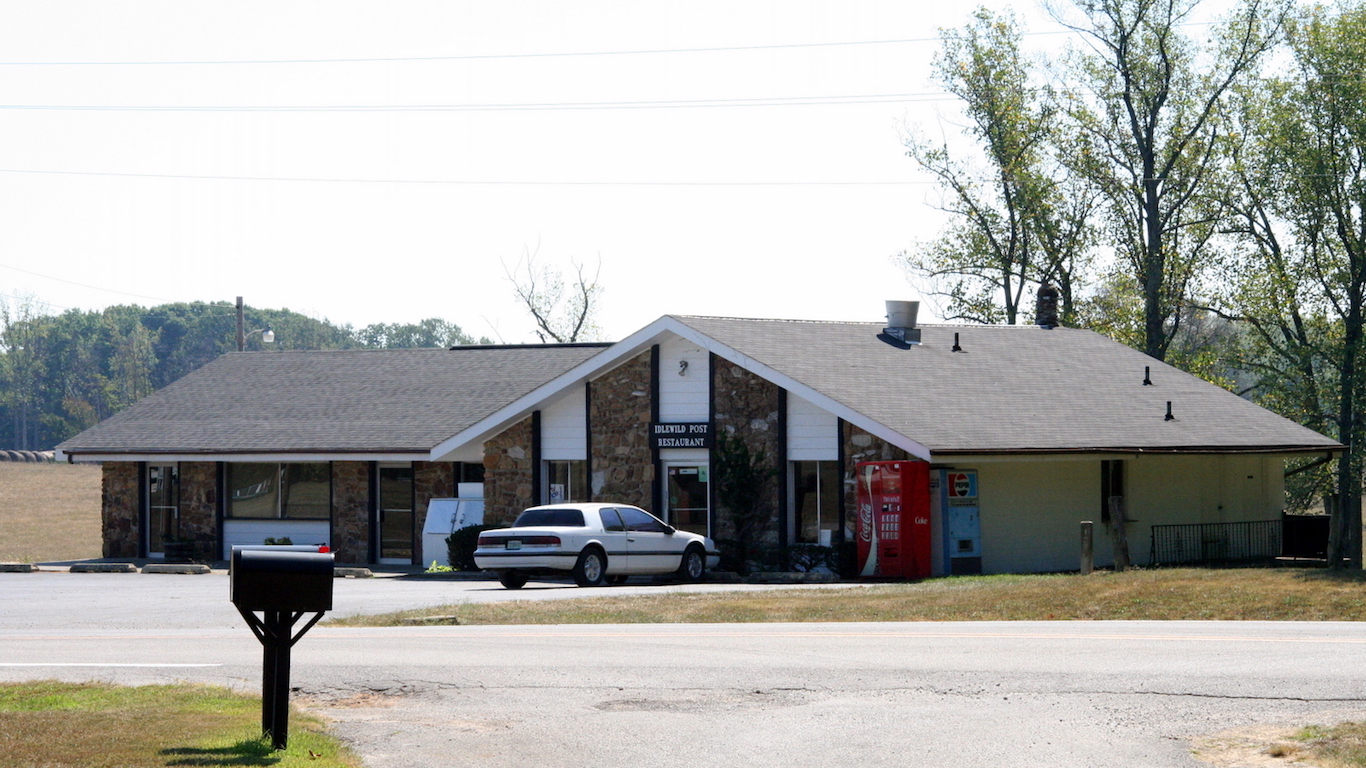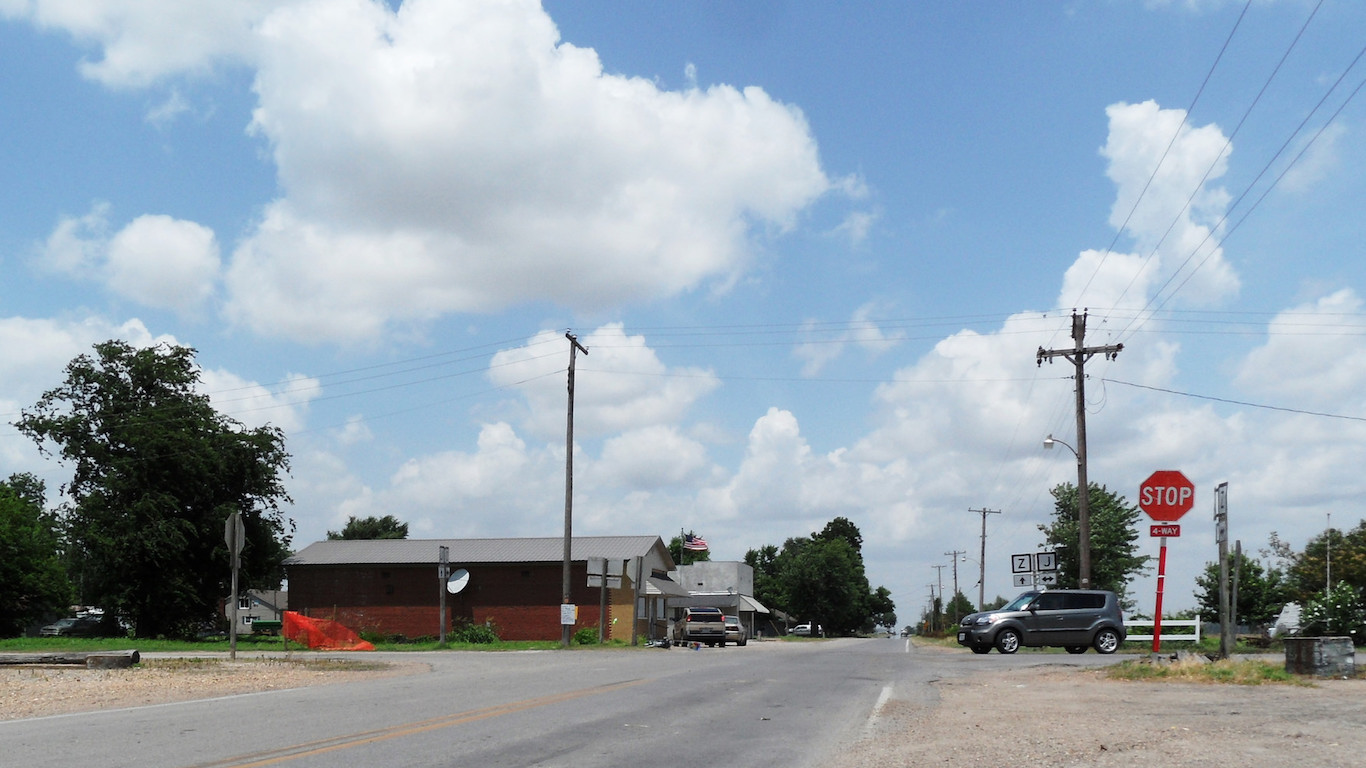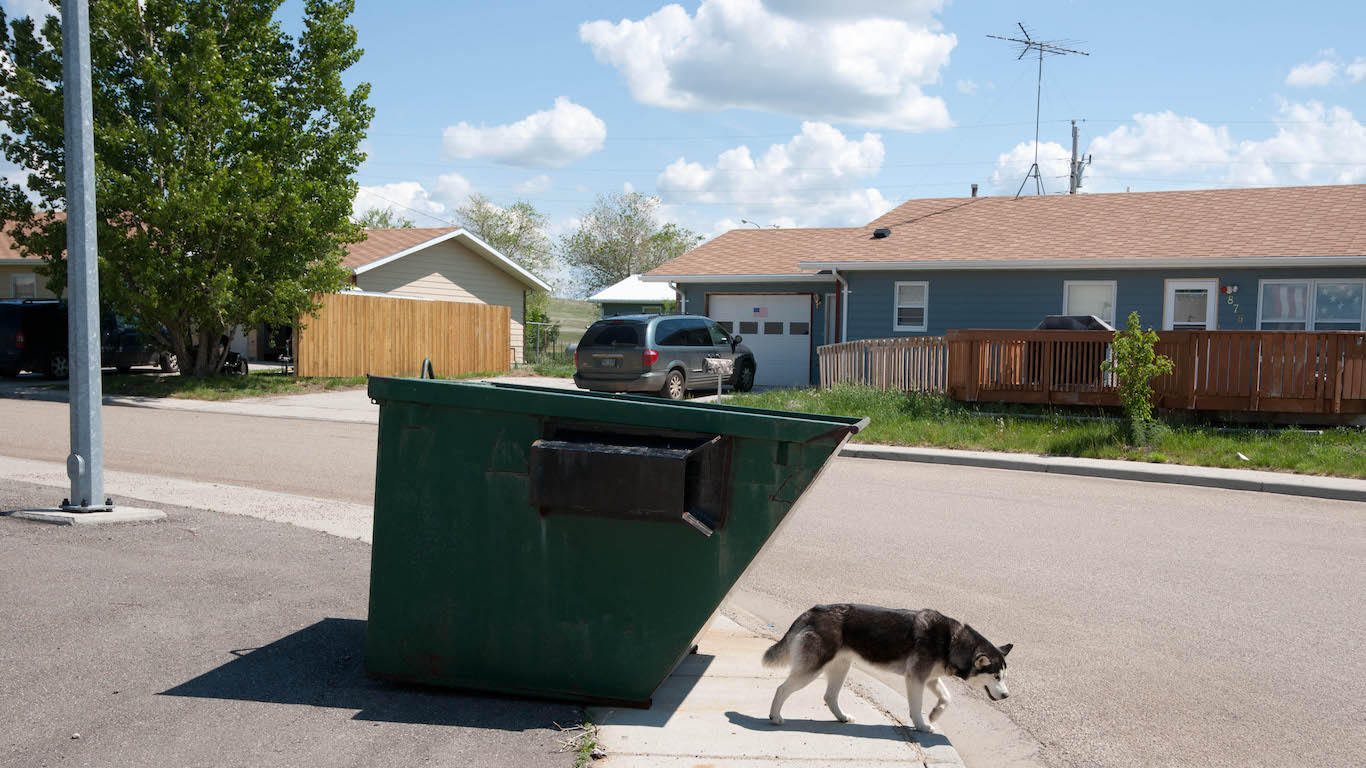Special Report
The Least Healthy County in Every State

Published:
Last Updated:

By many health measures, the United States, a nation of over 320 million, is an anomaly. Despite health spending approaching $10,000 per person — which amounts to twice and even three times the spending in other affluent nations — the United States ranks 28th in life expectancy among wealthy countries, according to the most recent Organization for Economic Co-operation and Development data.
Understanding the obstacles the United States faces in achieving better health requires a review of the regional differences in the behaviors, health care, and socioeconomic conditions that can affect health. 24/7 Wall St. reviewed county-level health rankings from County Health Rankings & Roadmaps, a Robert Wood Johnson Foundation and University of Wisconsin Population Health Institute joint program.
[in-text-ad]
The health of Americans varies tremendously not just between states, but within each state. In some U.S. counties — even in the healthiest states — health outcomes are surprisingly poor, especially for one of the wealthiest nations on earth. In Collier County, Florida, the premature mortality rate — people dying of largely preventable causes before age 75 — is 216 deaths per 100,000 residents. In Union County, Florida, the rate is 924 premature deaths per 100,000 people.
Click here to see the least healthy county in every state.
How long and how well people live are consequences of many health factors, which include behavioral indicators such as exercise habits, smoking, obesity, and alcohol consumption rates; and socioeconomic indicators such as violent crime, unemployment, child poverty, and teen birth rates, as well as the ratio of residents to physicians.
Much of the recent conversation about health care in the United States has been about access to health coverage. In an interview with 24/7 Wall St., Marjory Givens, deputy director of data and science at the County Health Rankings & Roadmaps program, pointed out that this is only one element explaining regional differences in health outcomes. “Access to affordable healthcare is an important element for helping communities to live long and well. But health is so much more than healthcare, and there are many other important elements in the local community that are important to be attentive to, like good jobs, quality education, [and] affordable housing,” said Givens.
Education in particular appears to have wide-reaching implications on health outcomes in a given area. “If you don’t have a quality education that allows you to get a good-paying job, the opportunities are limited to you, and that will influence the choices you can make,” Givens added. Each state’s least healthy county has a lower rate of college attainment than its state’s share.
In a number of states, the least healthy county also overlaps at least one Native American reservation, where poor economic conditions, unhealthy behaviors, and the resulting negative health outcomes are far more common than elsewhere. “Historically … Native American communities have experienced historical trauma and discrimination,” Givens noted. “[T]hese are communities that have experienced disinvestment, and high rates of unemployment and poverty, and these are issues that shape your health and well-being.” In 11 of the 50 counties on this list, at least 40% of the population is American Indian or Alaskan.
To identify the least healthy county in every state, 24/7 Wall St. reviewed county-level data from County Health Rankings & Roadmaps, a Robert Wood Johnson Foundation and University of Wisconsin Population Health Institute joint program. Rankings are based on overall health outcomes — a weighted composite of length of life, quality of life — and overall health factors. The health factors component is itself a weighted composite of healthy behaviors, clinical care, social and economic factors, and physical environment measures. Data compiled is for the most recent year available. Counties and county equivalents were considered.
This is the least healthy county in each state.

1. Alabama
> Least healthy county: Wilcox
> Pct. without health insurance: 16.3%
> Pct. limited access to healthy food: 33.0%
> Obesity rate: 44.9%
Alabama is one of the least healthy states in the country, and in Wilcox County residents are far less healthy than the state as a whole. The area’s annual premature death rate — people dying before age 75 largely of preventable causes — is 773 per 100,000 county residents. This is a far higher rate than the comparable statewide rate of 464 per 100,000, which itself is worse than all but two other states. Obesity is a primary cause of a number of deadly health conditions, and in Wilcox County, 44.9% of adults are obese, the sixth highest obesity rate of any U.S. county.
[in-text-ad]

2. Alaska
> Least healthy census area: Yukon-Koyukuk
> Pct. without health insurance: 31.4%
> Pct. limited access to healthy food: 23.1%
> Obesity rate: 28.3%
The Yukon-Koyukuk census area, the least healthy county in Alaska, is also one of the least healthy counties or county equivalents in the United States. Smokers die an average of 10 years earlier than nonsmokers, and 31.5% of Yukon-Koyukuk adults smoke regularly, far more than the 19.1% adult smoking rate statewide. Also taking into account the 25.8% of Yukon-Koyukuk adults who do not exercise, unhealthy behaviors among many census area residents have likely contributed to poor health outcomes. The area’s premature mortality rate of 660 deaths per 100,000 people is one of the highest premature mortality rates nationwide.

3. Arizona
> Least healthy county: Apache
> Pct. without health insurance: 21.0%
> Pct. limited access to healthy food: 26.4%
> Obesity rate: 35.2%
In Apache County, Arizona’s least healthy county, residents are more likely to spend time mentally or physically ill than nearly any other U.S. county’s population. On a national level, adults on average spend 3.6 days a month feeling physically unwell and 3.7 days in poor mental health. In Apache County, adults spend 6.2 days feeling physically unwell and 5.8 days in poor mental health, the seventh highest and highest such shares of any U.S. county.
Native American reservation lands comprise well more than half of the county’s geographic area. About 73% of the population is American Indian. American Indians are significantly more likely than the average American to live in extreme poverty and struggle with other conditions that can lead to poor health.

4. Arkansas
> Least healthy county: Phillips
> Pct. without health insurance: 12.6%
> Pct. limited access to healthy food: 31.6%
> Obesity rate: 45.5%
Phillips County, situated along the banks of the Mississippi River in Southeast Arkansas, is the least healthy county in the state. Nearly one-third of adults in the county report being in fair or poor health compared to 22.7% of state residents. Poor self-reported health outcomes are likely the result of unhealthy behaviors. Adults in Phillips County are more likely to smoke and lead sedentary lifestyles than the typical Arkansas resident. In addition, some 45.5% of the county’s adult population is obese, the fourth largest share of any U.S. county.
[in-text-ad-2]

5. California
> Least healthy county: Kern
> Pct. without health insurance: 14.5%
> Pct. limited access to healthy food: 14.3%
> Obesity rate: 30.3%
Kern County is one of the largest oil producing U.S. counties, accounting for more than 70% of California’s total petroleum output. While Kern’s massive oil production has historically been a boon for the area’s economy, in recent years the worldwide slump in oil prices has led to widespread layoffs and 10.2% unemployment — roughly twice the national rate. Economic hardship has been linked to an increase in unhealthy behaviors, which often result in an increased risk of disease or mortality. Roughly 23% of county adults say they are in fair or poor health, far more than the corresponding 18% and 15% state and national shares.

6. Colorado
> Least healthy county: Costilla
> Pct. without health insurance: 20.7%
> Pct. limited access to healthy food: 9.3%
> Obesity rate: 21.9%
Costilla, the oldest and least healthy county in Colorado, is situated along the state border with New Mexico. Colorado is one of the healthiest states in the country, and even the largely rural Costilla County is far healthier than the United States as a whole in several important measures. The county’s 21.9% obesity rate, while higher than the statewide rate of 20.2%, is well below the 28.0% national rate. Adults in Costilla County are also less likely to drink to excess or smoke than the typical American.
[in-text-ad]

7. Connecticut
> Least healthy county: New Haven
> Pct. without health insurance: 8.0%
> Pct. limited access to healthy food: 13.9%
> Obesity rate: 26.5%
New Haven County, home to the cities of New Haven and Waterbury, is Connecticut’s least healthy county. However, Connecticut is healthier than the country as a whole, and even New Haven County’s population is in better health than the U.S. population overall. For example, obesity is a causal factor for a number of poor health outcomes. In New Haven County, 26.5% of adults are dangerously overweight, a smaller share than the nationwide 28% obesity rate. The county also fares better than the nation in other health behavior-related factors, such as smoking and physical inactivity.

8. Delaware
> Least healthy county: Kent
> Pct. without health insurance: 9.2%
> Pct. limited access to healthy food: 13.4%
> Obesity rate: 32.8%
Kent County, home to Delaware’s capital city of Dover, is the least healthy of the state’s three counties. Partially because there are so few counties in the state, health outcomes are only slightly worse in Kent than they are across Delaware as a whole. Some 17.0% of adults in Kent County report being in fair or poor health, compared to 16.7% of adults throughout Delaware. Similarly, Kent County’s premature mortality rate of 390 deaths per 100,000 residents is just slightly higher than the statewide rate of 340 premature deaths per 100,000 people.

9. Florida
> Least healthy county: Gadsden
> Pct. without health insurance: 20.0%
> Pct. limited access to healthy food: 24.4%
> Obesity rate: 36.5%
An unhealthy diet is linked to a number of negative health outcomes. Frequent consumption of unhealthy food can lead to weight gain and many of the problems associated with obesity. Residents of Gadsden County, Florida’s least healthy county, are the most likely in the state — and among the most likely in the nation — to struggle with food insecurity. Located in Florida’s Panhandle, northeast of the state capital of Tallahassee, nearly one in four county residents did not have access to a reliable source of food at some point in the past year. By comparison, the statewide share is only about 16%. Partially as a result, Gadsden County’s obesity rate is 36.5%, over 10 percentage points higher than the comparable statewide rate.
[in-text-ad-2]

10. Georgia
> Least healthy county: Clay
> Pct. without health insurance: 19.7%
> Pct. limited access to healthy food: 29.8%
> Obesity rate: 29.8%
Clay County, situated in southwestern Georgia along the Alabama state border, is the least healthy county in the state. Adults in the county have an average of 6.0 physically unhealthy days a month, far more than the comparable statewide figure of 3.7 days. Poor physical health is likely attributable to bad habits. More than one in four county adults smoke, and about 30% get no exercise beyond getting up and going to work. In contrast, only 17.7% of adults in Georgia smoke and 23.4% lead physically sedentary lives.

11. Hawaii
> Least healthy county: Hawai’i
> Pct. without health insurance: 7.3%
> Pct. limited access to healthy food: 14.2%
> Obesity rate: 22.7%
Hawai’i County, which comprises the entire Island of Hawai’i, is the least healthy county in Hawaii. Still, island residents are in better health than the average American in a number of measures. The county’s 22.7% adult obesity rate is the highest of any county in the state, yet far lower than the 28.0% national rate. Similarly, while the county’s 15.9% smoking rate is also the highest statewide, it is still smaller than the 18.0% national rate. According to the National Institutes of Health, smoking and obesity are the two leading causes of preventable deaths in the United States. The county’s annual premature mortality rate of 310 deaths before the age of 75 per 100,000 people is the highest in the state.
[in-text-ad]

12. Idaho
> Least healthy county: Benewah
> Pct. without health insurance: 17.8%
> Pct. limited access to healthy food: 17.5%
> Obesity rate: 30.1%
Benewah County, Idaho’s least healthy county, is located on Idaho’s western border with Washington and is partially comprised of the Coeur d’Alene Indian Reservation. Across the state, about 310 out of every 100,000 residents die prematurely each year, largely due to preventable causes. In Benewah County, the premature mortality rate is over 500 deaths per 100,000 residents. One likely cause of the high premature death rate in the county is injury, such as those suffered on the job or from drug overdose. The annual rate of injury death rate in Benewah County is nearly twice the national rate of about 60 injury deaths per 100,000 residents.

13. Illinois
> Least healthy county: Alexander
> Pct. without health insurance: 10.5%
> Pct. limited access to healthy food: 24.0%
> Obesity rate: 28.4%
Situated along the state’s border with Missouri, Alexander is the southernmost county in Illinois. It is also the least healthy county in the state. In Alexander County, preventable deaths are far more common than they are across Illinois as a whole. The county’s premature mortality rate of 552 deaths per 100,000 people is much higher than the statewide rate of 320 per 100,000 residents.The county’s high premature death rate is partially attributable to unhealthy behaviors. The typical adult in Alexander County is more likely to be obese, more likely to smoke, and less likely to exercise than the typical adult statewide.

14. Indiana
> Least healthy county: Crawford
> Pct. without health insurance: 15.7%
> Pct. limited access to healthy food: 14.6%
> Obesity rate: 33.0%
Crawford County residents appear to have a worse overall diet than the Indiana population as a whole, as 33% of county adults are obese — a slightly larger share than the 31.7% statewide obesity rate. The county has a higher obesity rate despite having better overall access to healthy food than people across the state as a whole.
Crawford County residents are less likely than residents statewide to have easy access to places for physical activity, like gyms or public parks, however. Partially as a result, sedentary lifestyles are more common in Crawford County than they are across Indiana as a whole.
[in-text-ad-2]

15. Iowa
> Least healthy county: Wapello
> Pct. without health insurance: 10.0%
> Pct. limited access to healthy food: 13.6%
> Obesity rate: 35.6%
Wapello County, located in the southeast corner of Iowa, is the least healthy county in the state. Roughly 30% of county adults engage in no physical activity outside of work, a much larger share than the comparable state and national inactivity rates of 24% and 22%. An estimated 35.6% of adults in the county are obese, compared to the state and national obesity rates of 31.3% and 28.0%. A sedentary lifestyle has likely led to adverse health outcomes for many area residents. The county’s annual premature mortality rate of 405 deaths per 100,000 residents is far higher than the statewide rate of 311 premature deaths per 100,000 residents.

16. Kansas
> Least healthy county: Wyandotte
> Pct. without health insurance: 18.9%
> Pct. limited access to healthy food: 18.1%
> Obesity rate: 36.2%
Wyandotte County comprises part of Kansas City, Kansas, and is the least healthy county in the state. Teen pregnancies are more likely to result in low birthweight or pre-term babies and often puts the mothers at increased risk of poverty and other factors that can result in poor health. Wyandotte County has a teen birth rate of 69 per 1,000 15-19 year old females, more than double the national rate. Teen pregnancy can also prevent young adults from furthering their educations. In Wyandotte County, just 73% of high school students graduate, about 10 percentage points less than the national average. Greater educational attainment can give residents a greater sense of control over their lives, resulting in healthier long-term choices.
[in-text-ad]

17. Kentucky
> Least healthy county: Harlan
> Pct. without health insurance: 11.6%
> Pct. limited access to healthy food: 22.2%
> Obesity rate: 36.5%
Located in the Eastern Kentucky Coalfield, Harlan County is representative of the poverty and health problems that have swept much of Appalachia since the decline of the U.S. coal industry in the mid-20th century. Today, nearly 40% of county adults do not exercise, 28% smoke, and 37% are obese — some of the largest shares in both Kentucky and the United States. Poor health behaviors have likely led to adverse health outcomes for many Harlan County residents. The county’s annual premature mortality rate — people dying before age 75 — is approximately 730 deaths per 100,000 residents, nearly the highest nationwide.

18. Louisiana
> Least healthy parish: East Carroll
> Pct. without health insurance: 18.3%
> Pct. limited access to healthy food: 32.4%
> Obesity rate: 42.1%
Louisiana is one of the least healthy states in the country, and East Carroll is the least healthy of the state’s 64 parishes. Throughout East Carroll Parish, 37.8% of adults report being in suboptimal health, the fifth largest share of any U.S. county or county equivalent. In comparison, only 21.0% of adults in Louisiana and 15.0% of American adults report being in fair or poor health.
Like many other counties on this list, East Carroll residents do not have many exercise options. Situated in the northeastern corner of the state along the Mississippi River, less than half a percent of the parish population has access to parks or recreation centers, compared to 84% of Americans.

19. Maine
> Least healthy county: Washington
> Pct. without health insurance: 17.8%
> Pct. limited access to healthy food: 17.2%
> Obesity rate: 28.5%
Washington County, the least healthy county in Maine, encompasses the cities of Calais and Eastport, some 40 towns, and the easternmost point in the United States.
People with health insurance are more likely to schedule regular doctor visits and receive preventative medical care. In Washington County, 17.8% of the population lacks health insurance, the largest share of any of the state’s 16 counties. A high uninsured rate may partially explain the county’s high premature mortality rate of about 409 deaths per 100,000 residents annually, the most of any county in Maine.
[in-text-ad-2]

20. Maryland
> Least healthy county: Baltimore City
> Pct. without health insurance: 9.8%
> Pct. limited access to healthy food: 23.8%
> Obesity rate: 33.7%
There are 23 counties in Maryland as well as one independent city that is considered a county equivalent. While most of the 23 counties are about as healthy as the U.S. as a whole or healthier, the city of Baltimore is one of the least healthy counties or county equivalents in the nation. Roughly 24% of Baltimore adults smoke, and 34% are obese — compared to the statewide smoking and obesity rates of 15% and 29%, respectively. According to the NIH, tobacco use and obesity are the two leading causes of preventable death in the United States. The premature mortality rate in Baltimore is 608 deaths per 100,000 residents annually, nearly twice the premature mortality rate for Maryland as a whole.

21. Massachusetts
> Least healthy county: Hampden
> Pct. without health insurance: 4.2%
> Pct. limited access to healthy food: 11.7%
> Obesity rate: 27.5%
Hampden County, located in southern Massachusetts along the state border with Connecticut, is the least healthy county in a relatively healthy state. Across the county, which includes Springfield, one of the state’s largest cities, 18.6% of adults report being in fair or poor health, a considerably larger share than the 14.2% of adults in Massachusetts and 15.0% of Americans.
Though it is less healthy that the state as a whole, Hampden County residents tend to be healthier than the typical American by some measures. For example, obesity is less common in Hampden County than it is nationwide, and fewer years of life are lost to premature death in the county than in the U.S. as a whole.
[in-text-ad]

22. Michigan
> Least healthy county: Wayne
> Pct. without health insurance: 12.2%
> Pct. limited access to healthy food: 22.0%
> Obesity rate: 33.5%
Wayne County encompasses downtown Detroit, and is representative of the poverty and violence that has befallen the area since the city’s economic decline in the late 20th century. Some 1,034 violent crimes are reported per 100,000 county residents annually, nearly the most of any U.S. county. An estimated 22% of residents do not have reliable access to healthy food, a much larger share than the state and national food insecurity rates of 16% and 15%, respectively. Such poor living conditions have likely led to adverse health outcomes throughout Wayne County. More than 19% of area adults report being in fair or poor health, the largest share of any county in the state.

23. Minnesota
> Least healthy county: Mahnomen
> Pct. without health insurance: 10.3%
> Pct. limited access to healthy food: 14.0%
> Obesity rate: 32.6%
Mahnomen County encompasses much of the Chippewa Nation’s White Earth Reservation, one of seven Chippewa reservations in Minnesota. Throughout the county, unhealthy behaviors and inadequate access to healthy food contribute to poor health outcomes. For example, about one in four county adults are smokers, and 14% of the population lacks reliable access to healthy food — each the largest such share in the state. Partially as a result, the county’s annual premature mortality rate of 510 deaths per 100,000 residents is nearly double the corresponding statewide figure.

24. Mississippi
> Least healthy county: Holmes
> Pct. without health insurance: 18.4%
> Pct. limited access to healthy food: 35.7%
> Obesity rate: 46.1%
Holmes County, Mississippi is the least healthy county in one of the least healthy states. Well over a third of the county’s population lacks reliable access to healthy food and, partially as a result, 46.1% of county adults are obese, the third largest share of any U.S. county.
Adults and children in single-parent households are more likely to engage in unhealthy behaviors than their counterparts. In Holmes County, more than half of all children are raised in single parent households, more than twice the corresponding 21% share of children nationwide.
[in-text-ad-2]

25. Missouri
> Least healthy county: Pemiscot
> Pct. without health insurance: 14.7%
> Pct. limited access to healthy food: 24.2%
> Obesity rate: 34.4%
The premature mortality rate in Pemiscot County, the least healthy county in Missouri, is close to twice the corresponding statewide rate. This high premature death rate is likely the result of both unhealthy behaviors and inadequate access to healthy options. For example, 28.6% of county adults are smokers compared to only only 22.3% of Missouri adults. Additionally, only 75.8% of the county’s population has reliable access to healthy food, and only 37.2% have access to venues for physical exercise — well below the 83.2% and 76.3% respective statewide shares.

26. Montana
> Least healthy county: Glacier
> Pct. without health insurance: 27.3%
> Pct. limited access to healthy food: 21.0%
> Obesity rate: 34.2%
Located between the Great Plains and the Rocky Mountains and on the lands of the Blackfeet Indian Reservation, Glacier County is the least healthy county in Montana. Like many reservations in the United States, the Blackfeet Nation struggles with poor living conditions and numerous health problems. Just 26% of county residents have adequate access to locations for physical activity, compared to 67% statewide.
The average smoker lives 10 years less than nonsmokers, and one in three Glacier County residents smoke regularly. For every 100,000 residents in Glacier County, 14,103 years of life are lost due to premature death annually — more than twice the years of life lost per 100,000 Montana residents.
[in-text-ad]

27. Nebraska
> Least healthy county: Thurston
> Pct. without health insurance: 17.5%
> Pct. limited access to healthy food: 18.4%
> Obesity rate: 41.8%
Thurston County, Nebraska encompases much of the Omaha Reservation and the Winnebago Reservation. The least healthy county in the state, Thurston’s premature mortality rate is more than double the corresponding statewide rate across Nebraska a whole. Poor access to healthy options may be partially to blame. Far larger than average shares of Thurston County’s population lack adequate access to both exercise venues and reliable sources of healthy food.
Unhealthy behaviors are also partially to blame for the poor health outcomes. Some 41.8% of county adults are obese, and 28.6% are smokers — each the largest share of any county in Nebraska.

28. Nevada
> Least healthy county: Mineral
> Pct. without health insurance: 15.5%
> Pct. limited access to healthy food: 17.8%
> Obesity rate: 28.0%
Located in western Nevada along the California state border, Mineral County is the least healthy county in Nevada. Employment provides individuals with income and often other benefits, such as insurance, which can help support a healthy lifestyle. In Mineral County, 10.5% of the labor force is unemployed, the highest jobless rate in the state. Pervasive unemployment may contribute to reports of poor health in the area. Adults in Mineral County experience an average of 4.7 mentally unhealthy days a month, more than in any other county in Nevada and well above the national average of 3.7 days.

29. New Hampshire
> Least healthy county: Coos
> Pct. without health insurance: 15.0%
> Pct. limited access to healthy food: 12.6%
> Obesity rate: 30.5%
New Hampshire is one of the healthiest states in the country by a number of measures. Coos County, which comprises the northern tip of the state, is New Hampshire’s least healthy county. However, the county’s population is actually healthier than the U.S. population in measures of self-reported health, food insecurity, and teen pregnancy. The county’s health record is not perfect, however. The county’s rate of nearly 100 injury deaths — many of which are likely the result of drug overdose — per 100,000 residents each year is one of the higher such rates in the country, and is well above the statewide rate of 68 incidents per 100,000 people.
[in-text-ad-2]

30. New Jersey
> Least healthy county: Cumberland
> Pct. without health insurance: 15.1%
> Pct. limited access to healthy food: 14.3%
> Obesity rate: 34.5%
Located in southern New Jersey due west of Atlantic City, Cumberland County is the least healthy county in the Garden State. Cumberland is one of only two counties in the state where more than one in three adults are obese. Many of the adults in the county who are dangerously overweight likely lead sedentary lives. Some 28.3% of county adults get no exercise beyond getting up and going to work, the largest share of any county in the state.

31. New Mexico
> Least healthy county: McKinley
> Pct. without health insurance: 26.2%
> Pct. limited access to healthy food: 25.3%
> Obesity rate: 35.1%
McKinley, the least healthy county in New Mexico, contains parts of the Zuni Indian Reservation, the Ramah Navajo Indian Reservation, and a number of other Native American communities. The county is one of the poorest in the country and struggles with many of the health problems common in reservations throughout the United States. More than 25% of residents lacks reliable access to healthy food, and 35% of residents are obese — each the largest such shares in the state. The county’s annual premature mortality rate of 546 deaths per 100,000 residents is far higher than the statewide rate of 374 premature deaths per 100,000 New Mexico residents.
[in-text-ad]

32. New York
> Least healthy county: Bronx
> Pct. without health insurance: 13.9%
> Pct. limited access to healthy food: 18.7%
> Obesity rate: 30.4%
One of five counties that comprise New York City, the Bronx is the least healthy county in New York state. Some 27.5% of county adults report being in fair or poor health, at least 10 percentage points more than every other county in the state. Despite near universal access to recreation centers and parks, approximately 31% of county adults get no exercise beyond getting up and going to work, the largest share of any county in the state.
Sexually transmitted diseases are also a considerable problem in Bronx County. The county’s chlamydia rate of 1,140 confirmed cases per 100,000 people is the highest in the state and among the highest in the U.S.

33. North Carolina
> Least healthy county: Robeson
> Pct. without health insurance: 21.7%
> Pct. limited access to healthy food: 21.7%
> Obesity rate: 39.6%
Across Robeson, the least healthy county in North Carolina, adults report an average of 5.6 mentally unhealthy days and 4.9 physically unhealthy days a month, the most of any county in the state. Unhealthy habits can be both mentally and physically harmful, and in Robeson, more than one in five adults are smokers and more than one in three get no physical exercise, each the largest share of any county in the state.
County residents’ inactive lifestyle may be attributable to a lack of access to exercise venues like parks and recreation centers in the county — barely 40% of residents have such access. In contrast, more than three-quarters of North Carolina residents have access to such venues.

34. North Dakota
> Least healthy county: Sioux
> Pct. without health insurance: 15.9%
> Pct. limited access to healthy food: 15.8%
> Obesity rate: 33.7%
Comprising the northernmost portion of the Standing Rock Reservation, Sioux County is one of several primarily Native American counties on this list. Sioux County is the least healthy county in North Dakota, and one of the least healthy nationwide. The county’s annual premature mortality rate of 1,208 deaths before the age of 75 per 100,000 people is the worst in the country. Sexually transmitted diseases are also a serious problem in the county. The chlamydia rate of 2,777 incidents per 100,000 people is also the highest in the United States.
[in-text-ad-2]

35. Ohio
> Least healthy county: Adams
> Pct. without health insurance: 12.7%
> Pct. limited access to healthy food: 18.1%
> Obesity rate: 31.1%
As the least healthy county in one of the least health states, Ohio’s Adams County is also one of the least healthy counties in the nation. An estimated 23.4% of county adults smoke, and 31.1% are obese — each larger shares than the national smoking and obesity rates of 18.0% and 28.0%, respectively. According to the NIH, tobacco use and obesity are the two leading causes of preventable death nationwide. There are 498 premature deaths per 100,000 county residents a year, far more than the statewide premature mortality rate of 382 per 100,000 people.

36. Oklahoma
> Least healthy county: Adair
> Pct. without health insurance: 25.5%
> Pct. limited access to healthy food: 19.2%
> Obesity rate: 38.6%
Fewer than one in five Adair County residents have adequate access to locations for physical activity, compared to more than four in five Americans nationwide. In addition to poor living conditions, Adair County residents have some of the worst health behaviors in the country. Roughly 29% of residents regularly smoke and 39% are obese, far more than the corresponding national rates of 18% and 28%. County adults report experiencing more than five days of poor mental as well as six of poor physical health per month on average, the most of any county in Oklahoma, and among the most in the country.
[in-text-ad]

37. Oregon
> Least healthy county: Jefferson
> Pct. without health insurance: 17.1%
> Pct. limited access to healthy food: 14.9%
> Obesity rate: 32.5%
The Warm Springs Reservation comprises much of Jefferson County, the least healthy county in Oregon. American Indians are significantly more likely than the average American to live in extreme poverty and struggle with other conditions that can lead to poor health. For example, only 58.5% of county residents have access to recreation centers, parks, and other venues for physical exercise, a far smaller share than the 87.7% share of Oregon residents. Likely partially as a result, county adults are less likely to exercise than adults statewide.
Inadequate physical activity can contribute to a number of health consequences, including weight gain. Across the county, 32.5% of adults are obese, a far larger share than the 26.4% obesity rate in Oregon.

38. Pennsylvania
> Least healthy county: Philadelphia
> Pct. without health insurance: 14.4%
> Pct. limited access to healthy food: 21.7%
> Obesity rate: 29.8%
Philadelphia County, which contains the entire city of Philadelphia, is the least healthy county in Pennsylvania. Although nearly all Philadelphia residents have adequate access to locations for physical activity, roughly 26% of county adults do not exercise, a larger share than the comparable state and national inactivity rates of 23% and 22%. One factor that can discourage residents from exercising outdoors is a high crime rate. In Philadelphia, there are 1,094 violent crimes reported per 100,000 residents per year, more than three times the statewide violent crime rate and the highest of any county in Pennsylvania.

39. Rhode Island
> Least healthy county: Providence
> Pct. without health insurance: 10.4%
> Pct. limited access to healthy food: 15.1%
> Obesity rate: 28.2%
Providence County, which contains Rhode Island’s capital city of Providence, is the least healthy county in the state. Rhode Island is one of the healthiest states in the country, however, so county residents rank better than the average American in a number of health measures. While the county’s 15.6% smoking rate is the second highest of any Rhode Island county, it is lower than the 18.0% national smoking rate. Similarly, while the premature death rate of 322 per 100,000 county residents is the highest in Rhode Island, it is lower than the average premature death rate of the majority of states.
[in-text-ad-2]

40. South Carolina
> Least healthy county: Marlboro
> Pct. without health insurance: 17.6%
> Pct. limited access to healthy food: 23.9%
> Obesity rate: 39.2%
Marlboro, South Carolina is located along the state’s northern border, almost directly across from Robeson, the least healthy county in North Carolina. Pervasive unhealthy behavior is partially responsible for poor health outcomes in Marlboro County. County adults are far more likely to smoke, be dangerously overweight, and not exercise than adults statewide.
Unhealthy behaviors can have serious consequences, and the county’s annual premature mortality rate of 637 deaths per 100,000 is the highest of any county in South Carolina.

41. South Dakota
> Least healthy county: Todd
> Pct. without health insurance: 16.6%
> Pct. limited access to healthy food: 23.4%
> Obesity rate: 38.0%
Todd County lies entirely within the Rosebud Indian Reservation and its population is 86.1% American Indian. The least healthy county in South Dakota, Todd County residents struggle with many of the poor living conditions and health problems common in reservations throughout the country. Fewer than 1% of residents have access to locations for physical activity, and 41% smoke regularly — the highest smoking rate nationwide. Smokers live 10 years less than nonsmokers on average, and more than one in every 100 county residents dies prematurely — the third highest premature death rate of any county nationwide.
[in-text-ad]

42. Tennessee
> Least healthy county: Lauderdale
> Pct. without health insurance: 13.9%
> Pct. limited access to healthy food: 22.8%
> Obesity rate: 38.3%
Affecting nearly every organ in the body and causing many diseases, smoking has serious health consequences. And in Lauderdale County, the least healthy in Tennessee, the smoking rate of 27.4% is the highest in the state. The high smoking rate likely contributes to poor health outcomes in the county. About 27% of county adults report being in suboptimal health, a far larger share than the 20% of state residents.
Obesity is far more common in Lauderdale than it is statewide. Some 38.3% of county adults are overweight compared to 31.8% of adults in Tennessee.

43. Texas
> Least healthy county: Brooks
> Pct. without health insurance: 23.1%
> Pct. limited access to healthy food: 12.1%
> Obesity rate: 27.2%
Located in the Rio Grande Valley just north of the U.S.-Mexico border, Brooks County is one of the poorest and least healthy counties in both the state and the country. Less than 42% of residents have adequate access to locations for physical activity, roughly half the 84% state share. An estimated 20.8% of residents smoke regularly, far more than the 15.2% statewide rate. Poor living conditions and health behaviors have led to some of the worst health outcomes in the country. More than two in five residents report being in suboptimal health, more than twice the statewide proportion and the highest of any county nationwide.

44. Utah
> Least healthy county: San Juan
> Pct. without health insurance: 20.2%
> Pct. limited access to healthy food: 19.0%
> Obesity rate: 26.7%
Located in southeastern Utah and encompassing part of Four Corners National Monument, San Juan County also contains part of the Navajo Nation Reservation. Native American reservations often struggle with challenges less common in other parts of the country. For example, only 32.2% of county residents have access to recreation centers, parks, and other venues for physical exercise — a far smaller share than the 87.3% of Utah residents. Additionally, 19% of the population does not have access to a reliable source of healthy food, the largest share of any county in the state. Likely partially as a result, adults in San Juan County are less likely to exercise and are more likely to be obese than residents statewide.
[in-text-ad-2]

45. Vermont
> Least healthy county: Orleans
> Pct. without health insurance: 7.7%
> Pct. limited access to healthy food: 14.5%
> Obesity rate: 28.5%
Located in the Northeast Kingdom along the U.S.-Canada border, Orleans County is the least healthy county in Vermont. While it ranks worst in the state, residents of Orleans County are not much worse off than the average American in a number of health measures. While the county’s 17.2% smoking rate is the highest in the state, it is still smaller than the 18.0% national smoking rate. Similarly, while the 13.3% of county adults who report being in fair or poor health is a larger share than the 11.4% state figure, it still lower than the 15.0% national rate.

46. Virginia
> Least healthy county: Petersburg City
> Pct. without health insurance: 15.2%
> Pct. limited access to healthy food: 28.1%
> Obesity rate: 41.4%
Poor health outcomes are far more common in Petersburg City than they are across Virginia as a whole. For example, the premature death rate of 681 deaths before age 75 per 100,000 people is more than double the corresponding statewide rate of 314 deaths per 100,000 people. Unhealthy diets may be partially to blame. Well more than one in four area residents lack a reliable source of healthy food, the largest share of any county in the state.
Unhealthy behaviors can thrive in the absence of strong support networks. In Petersburg City, 43% of children are raised in single parent households, the highest share of any county in the state more than double the corresponding 21% share of children nationwide.
[in-text-ad]

47. Washington
> Least healthy county: Ferry
> Pct. without health insurance: 16.5%
> Pct. limited access to healthy food: 18.9%
> Obesity rate: 28.1%
While Washington is one of the healthiest states in the country, Ferry County is the least healthy county in the state and even one of the least healthy in the country. An estimated 18.9% of residents struggle to regularly access fresh and healthy food, far more than the 13.7% state rate and the 14.8% national rate. The area’s poor living conditions likely lead to adverse health conditions for many residents. County adults report experiencing nearly five days of poor mental as well as nearly five of poor physical health per month on average, the most of any county in Washington.

48. West Virginia
> Least healthy county: McDowell
> Pct. without health insurance: 13.9%
> Pct. limited access to healthy food: 22.1%
> Obesity rate: 42.1%
McDowell County, West Virginia is the least healthy county in one of the least healthy states in the country. Adults in West Virginia report an average of 5.1 physically unhealthy days a month and 4.8 mentally unhealthy days, each the most of any state. In McDowell County, adults report an even higher 6.0 physically unhealthy days and 5.5 mentally unhealthy days a month.
The health of McDowell’s population is likely undermined by the poor economic conditions many in the county face. Some 13.0% of the county’s labor force is unemployed, one of the highest jobless rates nationwide. Because many Americans receive health insurance through their employer, the county’s high unemployment may partially explain the county’s 13.9% uninsured rate, the highest of any county in West Virginia.

49. Wisconsin
> Least healthy county: Menominee
> Pct. without health insurance: 13.9%
> Pct. limited access to healthy food: 17.9%
> Obesity rate: 42.5%
In Menominee County, Wisconsin, about 80% of the population is American Indian, one of the largest shares of any U.S. county. The county also struggles with many of the health problems common in Native American communities throughout the United States. An estimated 35.7% of county residents smoke, and 42.5% are obese — each the largest such share in Wisconsin and among the largest shares of any county nationwide. According to the NIH, tobacco use and obesity are the two leading causes of preventable death in the United States. The county’s annual premature mortality rate of 645 deaths per 100,000 residents is more than twice the premature mortality rate for Wisconsin as a whole.
[in-text-ad-2]

50. Wyoming
> Least healthy county: Fremont
> Pct. without health insurance: 20.3%
> Pct. limited access to healthy food: 13.6%
> Obesity rate: 28.3%
More than one in five adults in Wyoming’s least healthy county, Fremont, are smokers — the largest share in the state. Adults in Fremont County are also more likely to be dangerously overweight and less likely to exercise than adults across the state as a whole. Unhealthy and reckless behavior in the county does not stop there. Some 45.5% of automobile fatalities in Fremont County involve alcohol, compared to 35.3% statewide.
Unhealthy behaviors have consequences, and Fremont County’s premature mortality rate of 518 deaths per 100,000 people is well above the corresponding statewide rate of 348 deaths per 100,000.
Are you ahead, or behind on retirement? For families with more than $500,000 saved for retirement, finding a financial advisor who puts your interest first can be the difference, and today it’s easier than ever. SmartAsset’s free tool matches you with up to three fiduciary financial advisors who serve your area in minutes. Each advisor has been carefully vetted and must act in your best interests. Start your search now.
If you’ve saved and built a substantial nest egg for you and your family, don’t delay; get started right here and help your retirement dreams become a retirement reality.
Thank you for reading! Have some feedback for us?
Contact the 24/7 Wall St. editorial team.